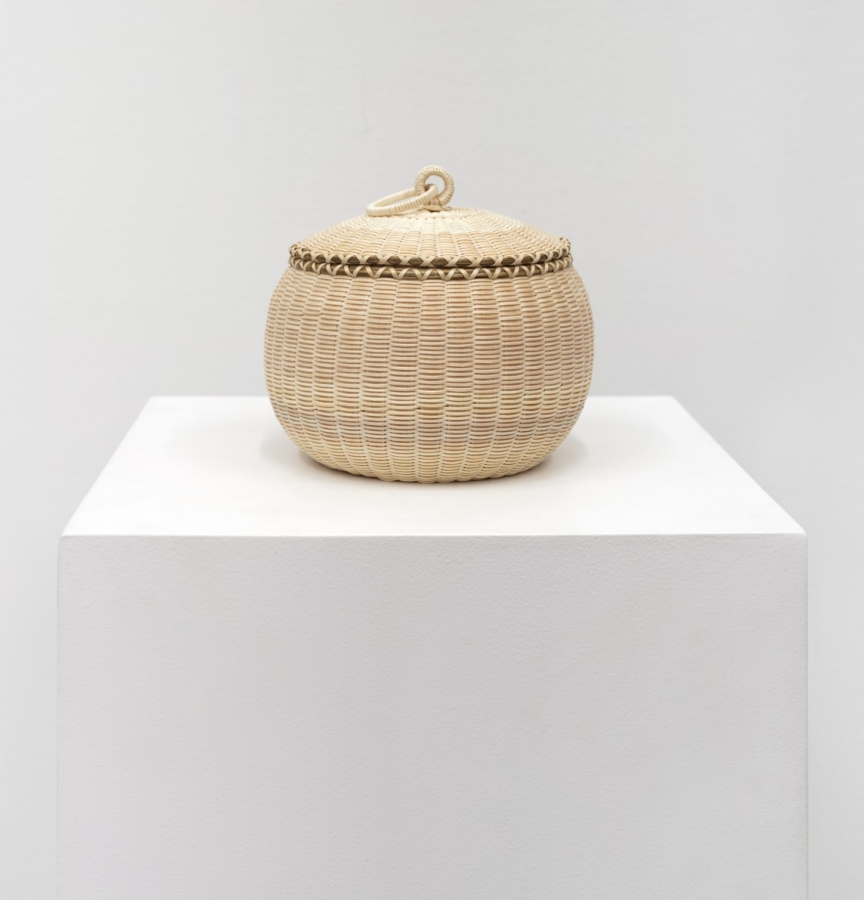October 30, 2024
Download as PDF
View on Art Basel

Jeremy Frey, Fine Weave, 2024. Courtesy of the artist and karma.
The seventh-generation Maine-based basket maker gives Indigenous techniques a contemporary twist. Museums, galleries, and collectors are taking notice.
When it comes to his craft, things move slowly for basket maker Jeremy Frey. Just one of the intricately textured baskets he is becoming known for can take months to create. He first treks through the woods of Central Maine to hand-harvest the ash trees that serve as his raw material, then takes days to strip their bark, pound their trunks to loosen up growth rings, and cut the layers into pliable strips. This is followed by the weeks in his studio weaving works until they are finessed enough to exhibit or sell.
But, these days, his career is running at full speed, as demand for both his precious objects and glimpses into his process continue to grow. Over the past 18 months, he has had his first solo exhibition at a major art museum, his first New York gallery show, and his first presentation at Art Basel Miami Beach. He has been profiled by The New York Times and PBS News Hour, and had works acquired by New York’s Metropolitan Museum of Art and the Baltimore Museum of Art. In August, he became the first Indigenous artist to win the prestigious Rappaport Prize, which comes with an unrestricted USD 50,000 grant.
Frey has been weaving baskets for two decades, evolving his works in increasingly contemporary ways, but even he is surprised by his current reception in the artworld. His debut solo was the number-two draw in the history of the Portland Museum of Art. ‘It was second only to a show of Winslow Homer, and I’m okay with that,’ says Frey, invoking the name of a New England icon. The traveling exhibition, titled ‘Woven’, opened at the Art Institute of Chicago for a four-month run on October 26. The mid-career retrospective features more than 50 of Frey’s baskets.
Frey has long been a star at galleries and fairs specializing in Native American painting, jewelry, crafts, and fashion. In 2011, he won Best of Show at the Santa Fe Indian Market, becoming the first basket maker in the event’s 100-year history to earn that honor. His recent embrace by the larger artworld is the result of ‘a thousand little things,’ he believes. Frey recognizes that there has been a burst of interest, among both curators and collectors, in works by Indigenous makers, and anyone who visits art fairs, galleries, or this year’s Venice Biennale can see that textiles are hot at the moment. ‘I feel like there’s [currently] a turning point in the artworld for a lot of things, and people are just looking at art differently,’ he tells me. And so they are finally seeing the things he has been making with great care all along. ‘The work has its own energy,’ he says. ‘And if I were bad at it, it wouldn’t be received in the same way, whether it was native or not.’
Frey was born on the Passamaquoddy Indian Township Reservation and he is a seventh-generation basket maker among his tribe, one of five communities that make up the Wabanaki Confederacy, which sprawls across northern New England and into Canada. He learned basket-weaving from his mother, but came to it later in life, during a period in his 20s when he was struggling with substance abuse and looking for a healthy distraction. She taught him the basics that she had learned from her own mother, the ‘over and under, ones and zeroes,’ he tells me, describing techniques that have been employed for centuries in terms that are now used to talk about computer coding.
But he took his practice in fresh directions, using ash, sweetgrass, cedar bark, and other materials to experiment with new shapes, incorporate different weaving patterns and braiding, and dying the wood to add in bright colors like purples, reds, and various shades of blue and turquoise. ‘Braiding the wood wasn’t done before – I pioneered that,’ he says. ‘And the tiny weave that you see on my baskets is also my innovation.’
Another of Frey’s signature moves involves creating two separate baskets of the same shape and connecting them so that the pieces have distinct inner and outer layers. Lately, he has been adding decorative touches to his works, embroidering images of animals and landscapes using porcupine quills. Next, he plans to develop a series of flat woven objects meant to be hung on walls. ‘I didn’t sit down to design elaborate baskets. I sat down and made baskets and, as I made them, ideas came to me,’ says Frey, who will also open a show titled ‘Unbound’ at Karma in Los Angeles on November 9.
Still, he never forsakes the core techniques of his ancestors. ‘That’s kind of been my whole goal, that [my work] is still identifiable as coming from the culture, and as being a vessel – all of those things which make native basketry what it is,’ he says. ‘But I’m making it so that you could put it in any contemporary or modern space, and it won’t look like something historical.’ That is only possible, he believes, if he practices his craft with reverence to his forebears. It’s why he heads to the Maine forest instead of to the local hobby shop for his supplies, the reason he dyes woods himself, makes his own basket molds and tools. ‘It’s because my ancestors did it that way, and I’m always going do it in the most respectful way I can.’



